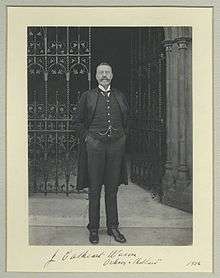Orkney and Shetland by-election, 1902

Orkney and Shetland is a constituency of the House of Commons of the Parliament of the United Kingdom. It elects one Member of Parliament (MP) by the first past the post system of election. In the Scottish Parliament, Orkney and Shetland are separate constituencies.
The Orkney and Shetland by-election was a Parliamentary by-election. It returned one Member of Parliament to the House of Commons of the United Kingdom, elected by the first past the post voting system.
Vacancy
Cathcart Wason had been Liberal Unionist MP for the seat of Orkney and Shetland since the 1900 General Election. In July 1902 he decided to cross the floor of the House to sit with the Liberal opposition. Leaving the Liberal Unionist Party, he cited Government policy on the army, the Education Bill and the Irish land question.[1] He faced criticism from the Unionists in his constituency and following pressure, he resigned his seat on 7 October 1902 to contest the subsequent by-election.
Electoral history
Since 1885, the seat had been always comfortably returned the Liberal Party candidate. Then the seat was surprisingly gained by Wason, standing as a Liberal Unionist in 1900;
| Party | Candidate | Votes | % | ± | |
|---|---|---|---|---|---|
| Liberal Unionist | John Cathcart Wason | 2,057 | 50.5 | +10.4 | |
| Liberal | Sir Leonard Lyell | 2,017 | 49.5 | -10.4 | |
| Majority | 40 | 1.0 | |||
| Turnout | 4,074 | 54.9 | -1.0 | ||
| Liberal Unionist gain from Liberal | Swing | ||||
Candidates

- Fifty-four-year-old sitting MP Cathcart Wason chose to fight his seat again, standing as an Independent Liberal. He had hoped to stand as the official Liberal candidate, but the local Liberal Association chose not to back him.[4] Although born in Scotland he moved to New Zealand and had served as an Independent Member of Parliament there. He returned to Britain in 1900 in time for the General Election to stand as a Liberal Unionist. His father, Rigby Wason had sat as a Whig MP and his older brother Eugene Wason was at the time a Liberal Party MP in Scotland.[5]
- The local Liberal Unionist Association selected 59-year-old Theodore Angier as their candidate to defend the seat. He had no connection with the islands. He was a member of the Liberal Unionist Council. He had been a sailor. He owned the family steamship business. He had volunteered for service in the South African War. He was standing for parliament for the first time.[6]
- In August 1902, the local Liberal Association had selected 47-year-old Thomas McKinnon Wood as their prospective candidate to re-gain the seat.[7] Although born in Stepney, his father had been born in Orkney where he was a farmer. Wood was a member of the London County Council for Central Hackney from 1892 and from 1897 he was leader of the Progressive Party and also served as Chairman of the council from 1898 to 1899. Wood stood unsuccessfully as a parliamentary candidate for East Islington in 1895 and Glasgow St. Rollox in 1900.[8]
Campaign
Polling Days were fixed for the 18–19 November 1902, over five weeks after Wason's resignation.
Result
Wason remarkably held his seat;
| Party | Candidate | Votes | % | ± | |
|---|---|---|---|---|---|
| Independent Liberal | John Cathcart Wason | 2,412 | 46.8 | +46.8 | |
| Liberal | Thomas McKinnon Wood | 2,001 | 38.8 | -10.7 | |
| Liberal Unionist | Theodore Vivian Samuel Angier | 740 | 14.4 | -36.1 | |
| Majority | 411 | 8.0 | |||
| Turnout | 5,153 | 68.1 | +13.2 | ||
| Independent Liberal gain from Liberal Unionist | Swing | ||||
Immediately following his re-election, Wason re-took the Liberal Party whip in the House of Commons.
Aftermath
By the time of the 1906 General Election, Wason had been fully integrated with the local Liberal Party and was re-elected as their official candidate;
| Party | Candidate | Votes | % | ± | |
|---|---|---|---|---|---|
| Liberal | John Cathcart Wason | 3,837 | 79.0 | +29.5 | |
| Liberal Unionist | C J Dunlop | 1,021 | 21.0 | -29.5 | |
| Majority | 2,816 | 58.0 | |||
| Turnout | 4,858 | 63.3 | +8.4 | ||
| Liberal gain from Liberal Unionist | Swing | ||||
McKinnon Wood was elected Liberal MP for Glasgow St Rollox at the 1906 General Election. Angier was knighted in 1904 and contested unsuccessfully, Gateshead at the 1906 General Election.
References
- ↑ Aberdeen Journal, 30 Jul 1902
- 1 2 The Constitiutional Year Book, 1904, published by Conservative Central Office, page 182 (206 in web page)
- ↑ British parliamentary election results 1885-1918 by Craig
- ↑ Aberdeen Journal, 18 Aug 1902
- ↑ ‘WASON, John Cathcart’, Who Was Who, A & C Black, an imprint of Bloomsbury Publishing plc, 1920–2007; online edn, Oxford University Press, Dec 2007 accessed 28 Nov 2013
- ↑ ‘ANGIER, Sir Theodore Vivian Samuel’, Who Was Who, A & C Black, an imprint of Bloomsbury Publishing plc, 1920–2007; online edn, Oxford University Press, Dec 2007 accessed 28 Nov 2013
- ↑ Aberdeen Journal, 18 Aug 1902
- ↑ ‘WOOD, Rt. Hon. Thomas McKinnon’, Who Was Who, A & C Black, an imprint of Bloomsbury Publishing plc, 1920–2007; online edn, Oxford University Press, Dec 2007 accessed 28 Nov 2013
- ↑ British parliamentary election results 1885-1918 by Craig
- ↑ British parliamentary election results 1885-1918 by Craig